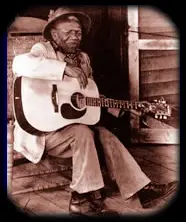FURRY LEWIS
 Of all the old Blues singers who were rediscovered in the 60s, Furry Lewis was by far the most engaging character. With his peg-leg, his inexhaustable stock of stories, his considerable skill with a guitar and his witty songs, he became a Blues Celebrity on TV, in movies and even in Playboy Magazine.
Of all the old Blues singers who were rediscovered in the 60s, Furry Lewis was by far the most engaging character. With his peg-leg, his inexhaustable stock of stories, his considerable skill with a guitar and his witty songs, he became a Blues Celebrity on TV, in movies and even in Playboy Magazine.
Walter Lewis was born in Greenville, Mississippi in 1893, and when the family moved to Memphis, his schoolmates gave him the name ‘Furry’. He built his first guitar himself and learned how to play from a local man, ‘Blind Joe’, who taught him ‘John Henry’ and ‘Casey Jones’, which remained in his repertoire for over seventy years.
Furry’s lovely picking and slide-guitar work;
When Furry travelled to Chicago in 1927 to record for Vocalion, he played with guitarist Landers Walton and the mandolin of Charles Jackson.
A second session was more successful, where Furry’s eccentric sense of timing and musical structure was used to explore the interplay between his wonderfully expressive voice and his intricate guitar work.
Over the next two years, Furry recorded many times for Victor and Vocalion, producing some superb Blues, but he never really became famous outside Memphis. Unable to make a living from music, he returned to sweeping the streets of his home town, playing mainly at home for friends and family, and sometimes busking on Beale Street.
Gospel-Blues gets a severe thrashing!
Sam Charters rediscovered Furry in 1959, when he recorded new versions of his songs and became a mainstay of the Blues revival circuit, playing coffee houses, concerts and Festivals. Giving up his job with the Memphis Sanitation Dept. after forty years, Furry became a living repository of Memphis Blues from its earliest days and his skill as a storyteller was as sharp as his singing and playing, which had not faded with the years. He was ideal material for documentary films, and he contributed to ‘The Blues’ and ‘American Roots Music’, among others. Furry’s easy manner in front of the camera made him a popular interviewee on TV, making several prime-time network appearances. Playboy Magazine ran a feature on him and he had parts in several movies, including ‘Dixie Dance Kings’ with Burt Reynolds, where he played himself. The novel, ‘Been Down So Long it Looks Like Up to Me’, is named from a line in one of Furry’s songs.
When Furry Lewis died in 1981, a chapter closed in the Story of Memphis Blues. Very few characters added more colour or more drama to its pages.
